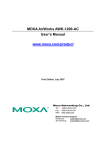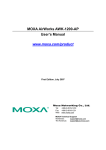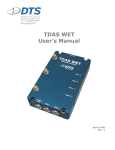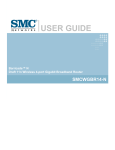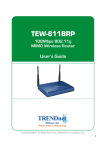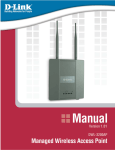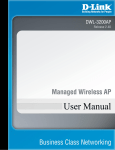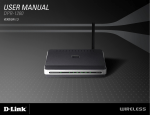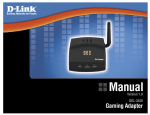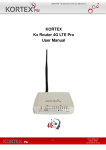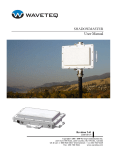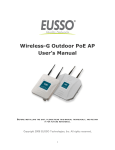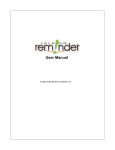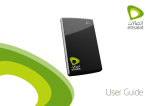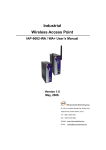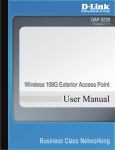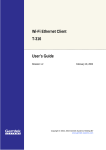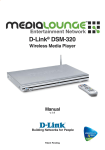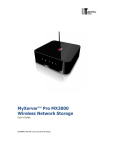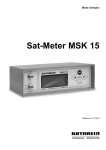Download AirWorks AWK-1200-AC User`s Manual v2
Transcript
Moxa AirWorks AWK-1200-AC User’s Manual www.moxa.com/product Second Edition, May 2008 © 2008 Moxa Inc., all rights reserved. Reproduction without permission is prohibited. Moxa AirWorks AWK-1200-AC User’s Manual The software described in this manual is furnished under a license agreement and may be used only in accordance with the terms of that agreement. Copyright Notice Copyright © 2008 Moxa Inc. All rights reserved. Reproduction without permission is prohibited. Trademarks MOXA is a registered trademark of Moxa Inc. All other trademarks or registered marks in this manual belong to their respective manufacturers. Disclaimer Information in this document is subject to change without notice and does not represent a commitment on the part of Moxa. Moxa provides this document “as is,” without warranty of any kind, either expressed or implied, including, but not limited to, its particular purpose. Moxa reserves the right to make improvements and/or changes to this manual, or to the products and/or the programs described in this manual, at any time. Information provided in this manual is intended to be accurate and reliable. However, Moxa assumes no responsibility for its use, or for any infringements on the rights of third parties that may result from its use. This product might include unintentional technical or typographical errors. Changes are periodically made to the information herein to correct such errors, and these changes are incorporated into new editions of the publication. Technical Support Contact Information www.moxa.com/support Moxa Americas: Toll-free: 1-888-669-2872 Tel: +1-714-528-6777 Fax: +1-714-528-6778 Moxa China (Shanghai office): Tel: +86-10-6872-3959/60/61 Fax: +86-10-6872-3958 Moxa Europe: Tel: +49-89-3 70 03 99-0 Fax: +49-89-3 70 03 99-99 Moxa Asia-Pacific: Tel: +886-2-8919-1230 Fax: +886-2-8919-1231 Table of Contents Chapter 1 Introduction ...............................................................................................1-1 Overview .............................................................................................................................. 1-2 Package Checklist................................................................................................................. 1-2 Product Features ................................................................................................................... 1-2 System Requirements ........................................................................................................... 1-2 Inline Power Injector (PoE).................................................................................................. 1-3 Chapter 2 Getting Started ..........................................................................................2-1 First Time Installation and Configuration............................................................................. 2-2 Locating the Data Input and PoE Ports................................................................................. 2-2 What to Check before You Install the AWK-1200-AC......................................................... 2-4 Basic Configuration.............................................................................................................. 2-5 Basic Configuration Steps ......................................................................................... 2-5 Logging into the Web Interface................................................................................. 2-5 Configuring Operating Mode, IP Address, Subnet Mask, Default Route IP, DNS Server IP.................................................................................................................... 2-7 Configuring the Wireless SSID................................................................................. 2-8 Configuring Wireless Encryption.............................................................................. 2-8 Changing the Supervisor Account & Password ........................................................ 2-9 Upgrading the Firmware ........................................................................................... 2-9 Chapter 3 Web Console Configuration .....................................................................3-1 BASIC .................................................................................................................................. 3-2 LAN .......................................................................................................................... 3-2 WIRELESS ............................................................................................................... 3-2 ADVANCED ............................................................................................................ 3-4 TOOLS ................................................................................................................................. 3-5 Admin........................................................................................................................ 3-5 Time .......................................................................................................................... 3-6 System....................................................................................................................... 3-7 Firmware ................................................................................................................... 3-7 STATUS................................................................................................................................ 3-8 Device Info................................................................................................................ 3-8 WIRELESS ............................................................................................................... 3-9 Logs......................................................................................................................... 3-10 Statistics .................................................................................................................. 3-11 Appendix A Specifications ........................................................................................... A-1 Appendix B Default Settings ........................................................................................ B-1 BASIC ..................................................................................................................................B-1 LAN ..........................................................................................................................B-1 WIRELESS ...............................................................................................................B-1 ADVANCED ........................................................................................................................B-1 TOOLS .................................................................................................................................B-2 ADMIN .....................................................................................................................B-2 TIME.........................................................................................................................B-2 Appendix C Regulatory Compliance Information ...................................................... C-1 1 Chapter 1 The following topics are covered in this chapter: Overview Package Checklist Product Features System Requirements Inline Power Injector (PoE) Introduction AirWorks AWK-1200-AC User’s Manual Introduction Overview The AWK-1200 Access Point/Bridge and AP Client is ideal for applications that are hard to wire, too expensive to wire, or use mobile equipment that connects to a TCP/IP network. The AWK-1200 series is rated to operate at temperatures ranging from -20 to 70°C, and its weatherproof design allows you to set up a WLAN, or extend existing wired networks to outdoor locations. In addition, you do not need to worry about setting up a power supply for outdoor applications, since the AWK-1200’s PoE (Power over Ethernet) design makes it easy to deploy. Package Checklist The product package contains the following items. y y y y y y y y y AWK-1200-AC 100 to 240 VAC, 50 to 60 Hz AC to 48V/0.375A DC switching adaptor 48 VDC, 0.375A Inline Power Injector (PoE) 30 m RJ45 CAT-5 Ethernet cable 1.8 m RJ45 CAT-5 cross-over Ethernet cable 1.8 m grounding wire Document and Software CD Wall/mast mounting kit Band clamp Product Features y y y y y y y IP67 rated for outdoor use RF transmit power: 802.11b mode @ 11 Mbps data rate RF transmit power: 802.11g mode @ 54 Mbps data rate Embedded 9 dBi patch directional antenna Supports 48 VDC 0.375A Power-over-Ethernet (PoE) MIB-I support MAC address based access control System Requirements Installing the AWK-1200-AC requires the following: y Windows-based PC/AT compatible computer (PC system requirements: better than PIII 800 or other 100% compatible equipment; OS: Windows 2000/XP), or Ethernet data device that has an RJ45 Ethernet port to run the configuration program, or a TCP/IP connection to the Ethernet network. y 10/100 Base-T RJ45 Ethernet cable for connecting to an Ethernet network. y AC power outlet (100 to 240V, 50 to 60 Hz) to supply power. 1-2 AirWorks AWK-1200-AC User’s Manual Introduction Inline Power Injector (PoE) The AWK-1200-AC is equipped with an Inline Power Injector module. The Inline Power Injector (PoE) delivers both data and power to the AWK-1200-AC through a single Ethernet cable, and provides the following benefits to improve the performance vs. installation cost ratio. y Great for areas that do not have a ready power supply, such as the roof of a house. y Allows placing the AWK-1200-AC unit closer to the antenna, to make installation easier, and reduce signal loss over antenna cabling. y Ethernet signal travels well over CAT 5 cable but 2.4 GHz signal doesn’t do as well over antenna cabling. y Ethernet cabling is much cheaper than antenna cabling. 1-3 2 Chapter 2 Getting Started This chapter describes the procedures for installing the AWK-1200-AC. The following topics are covered: First Time Installation and Configuration Locating the Data Input and PoE Ports What to Check before You Install the AWK-1200-AC Basic Configuration ¾ Basic Configuration Steps ¾ Logging into the Web Interface ¾ Configuring Operating Mode, IP Address, Subnet Mask, Default Route IP, DNS Server IP ¾ Configuring the Wireless SSID ¾ Configuring Wireless Encryption ¾ Changing the Supervisor Account & Password ¾ Upgrading the Firmware AirWorks AWK-1200-AC User’s Manual Getting Started First Time Installation and Configuration After unpacking the system, make sure the following items are present and in good condition. Refer to pictures below to see what each item looks like. 1. 2. 3. 4. 5. 6. 7. 8. 9. AWK-1200-AC 100 to 240VAC, 50 to 60 Hz AC to 48V/0.375A DC switching adaptor Inline Power Injector (PoE); 48 VDC, 0.375A RJ45 CAT-5 Ethernet cable; 30 m (optional) RJ45 CAT-5 cross-over Ethernet cable; 1.8 m (optional) Grounding wire 1.8 m Document & Software CD Wall/mast mounting kit, including one band clamp Screws 1. AWK-1200-AC 2. Adaptor 3. PoE 4. 30 m cable 5. 1.8 m cable (optional) 6. Grounding wire 7. CD 8. Wall mount 9. Screws Locating the Data Input and PoE Ports After unpacking the system, locate the following ports on the AWK-1200-AC unit. The numbers next to each item refer to the pictures in Figure 2-1. Interface on the AWK-1200-AC Unit y Ethernet Port 1: for connecting the 30 m RJ45 CAT-5 Ethernet cable. Interface on the Inline Power Injector y Data Input Port 2: for connecting the cross-over Ethernet Cable to a PC or straight-through Ethernet cable to a Hub, Switch, or Router. y DC Input Port 3: power adaptor; 48V, 0.375A DC input. y Power & Data Output Port 4: for connecting the 30 m RJ45 CAT-5 Ethernet cable. y Grounding Port 5: for connecting grounding wire. 2-2 AirWorks AWK-1200-AC User’s Manual Getting Started Device Figures 4 2 5 3 POE picture1 POE picture2 1 Figure 2-1 Power and Data Interface location on the PoE denoted by numbers 1-5. Mounting the AWK-1200-AC on a Wall or Mast y The AWK-1200-AC can be mounted on the wall, and you can use the Wall Mount kit to mount the AWK-1200-AC as shown in Figure 2-2. Figure 2-2 2-3 AirWorks AWK-1200-AC User’s Manual Getting Started y You can also mount the AWK-1200-AC to the mast as shown in Figure 2-3. Figure 2-3 What to Check before You Install the AWK-1200-AC Before installing the AWK-1200-AC for outdoor applications or hard-to-reach locations, we recommend configuring and testing all devices first. For configuring the AWK-1200-AC, please follow the steps below to power up the AWK-1200-AC (refer to Figure 2-4). Step 1: Connect the DC plug of the AC/DC power adapter into the DC Input Port of the Inline Power Injector and the wall-mount plug into a power outlet or power strip (refer to page 2-2). The Power LED on the Inline Power Injector will light up. Step 2: Run the cross-over Ethernet cable from the Data Input Port (refer to page 2-2) to the Ethernet port on a PC. Step 3: Connect the 30 m CAT 5 Ethernet cable to the AWK-1200-AC. Hand tighten the connector. Step 4: Connect the other end of the 30 m CAT 5 cable to the PoE labeled AP/CB. This is the power side of the PoE that will power up the AWK-1200-AC. When the AWK-1200-AC receives power over the Ethernet cable, the AWK-1200-AC will start its boot up sequence, and the Active LED on the Inline Power Injector will light up. You can use a web browser, such as Microsoft Internet Explorer or Netscape Navigator, to configure the AWK-1200-AC from a remote host or PC. 2-4 AirWorks AWK-1200-AC User’s Manual Getting Started Figure 2-4 Basic Configuration Basic Configuration Steps This section describes a basic 2-step configuration procedure to set up the AWK-1200-AC. Step 1: Modify the factory-default parameters on the web page “/BASIC/LAN/”, click Save Settings to save the changes, and then click Continue. Step 2: Modify the factory-default parameters on the web page “/BASIC/Wireless/”, click Save Settings to save the changes, and then click Reboot the Device to activate the configuration changes. Logging into the Web Interface Users can access and configure the AWK-1200-AC through a web browser interface. Web Configuration Before configuring the AWK-1200-AC, you need to know the IP Address assigned to the unit. The factory default IP Address is 192.168.127.254. To establish a connection, type http://192.168.127.254 in the browser’s address field. Web Access Procedures Once you identify the IP Address assigned to the AWK-1200-AC, use the web browser to configure the AWK-1200-AC through the browser interface. The following procedure explains how to configure each item. Step 1: Open your browser and enter the IP address. Step 2: Press <ENTER>. The AWK-1200-AC Login screen should appear as shown in Figure 2-5. 2-5 AirWorks AWK-1200-AC User’s Manual Getting Started Figure 2-5 Step 3: Enter “root” in the Password fields, and then click Log In to enter the web configuration user interface screen as shown below. Figure 2-6 2-6 AirWorks AWK-1200-AC User’s Manual Getting Started Web Configuration Structure The web configuration user interface shown above in Figure 2-6 is grouped into a tree structure, and contains the following settings or information. y TOOLS ¾ ADMIN ¾ TIME ¾ SYSTEM ¾ FIRMWARE y STATUS ¾ DEVICE INFO ¾ WIRELESS ¾ LOGS ¾ STATISTICS y HELP ¾ MENU ¾ BASIC ¾ ADVANCED ¾ TOOLS ¾ STATUS ¾ GLOSSARY Move through the tree by clicking on an icon to expand or collapse the tree. The nodes on the tree represent web pages that allow viewing and modifying the parameters. Configuring Operating Mode, IP Address, Subnet Mask, Default Route IP, DNS Server IP LAN Settings The LAN (Local Area Network) settings for the Access Point are IP Address Mode, IP Address, Subnet Mask, and Default Gateway. The Access Point’s local network (LAN) settings are configured based on the IP Address and Subnet Mask assigned in this section. The IP address is also used to access this Web-based management interface. This option is available in the “/BASIC/LAN/” page as shown in Figure 2-7. Figure 2-7 IP Address Mode Select DHCP to get the IP settings from a DHCP server on your network. Select Static to use the IP settings specified on this page. 2-7 AirWorks AWK-1200-AC User’s Manual Getting Started IP Address The IP address of the AC on the local area network. Your local area network settings are based on the address assigned here. For example, 192.168.1.1. Subnet Mask The subnet mask of your AWK-1200-AC on the local area network. Default Gateway This is the IP address of the gateway that connects you to the Internet. Configuring the Wireless SSID Wireless Network Name (also called the SSID) When you are browsing for available wireless networks, this is the name that will appear in the list (unless Visibility Status is set to Invisible; see below). This name is also referred to as the SSID. For security purposes, we highly recommend that you change the pre-configured network name. This option is available on the “/BASIC/WIRELESS/” page as shown in Figure 2-8. Figure 2-8 Configuring Wireless Encryption The AWK-1200-AC supports 64-bit and 128-bit WEP encryption. For 64-bit WEP encryption, the encryption key consists 10 hexadecimal characters (0-9 and A-F) or 5 ASCII characters. For 128-bit WEP encryption, the encryption key consists of 26 hexadecimal characters (0-9 and A-F) or 13 ASCII characters. Modify the WEP encryption parameters on the web page “/BASIC/WIRELESS/WIRELESS SECURITY MODE”. If you choose “WEP” enter 1 to 15 characters in the WEP Key field, and then click Save Setting, Reboot the Device. 2-8 AirWorks AWK-1200-AC User’s Manual Getting Started Changing the Supervisor Account & Password Enter the TOOLS Æ ADMIN page, shown below in Figure 2-9. Figure 2-9 ADMIN PASSWORD Change the ADMIN PASSWORD’s user name and password in the ADMIN PASSWORD Account field, click Save Setting, and then Reboot the Device to activate the configuration changes. Upgrading the Firmware Updating the Firmware Enter the TOOLS Æ FIRMWARE page as shown in Figure 2-10 to upgrade the AWK-1200-AC’s firmware. You must select which file (Program image) you want to upgrade, and then click the Upload button to start the upgrade process. NOTE It takes about 1 minute to complete the restart process. 2-9 AirWorks AWK-1200-AC User’s Manual Getting Started Figure 2-10 ATTENTION The Part 15 radio device operates on a non-interference basis with other devices operating at this frequency when using integrated antennas. Any changes or modification to the product not expressly approved by the Original Manufacture could void the user’s authority to operate this device. ATTENTION To meet regulatory restrictions and to ensure a safe installation, we strongly recommend that this product is professionally installed. 2-10 3 Chapter 3 Web Console Configuration In this chapter, we will explain each web management page of the Web-based Network Manager. The following topics are covered in this chapter: BASIC ¾ LAN ¾ WIRELESS ¾ ADVANCED TOOLS ¾ Admin ¾ Time ¾ System ¾ Firmware STATUS ¾ Device Info ¾ WIRELESS ¾ Logs ¾ Statistics AirWorks AWK-1200-AC User’s Manual Web Console Configuration BASIC LAN These are the IP address settings of the LAN (Local Area Network) for the AWK-1200-AC. The AWK-1200-AC’s Local Area Network (LAN) settings are configured based on the IP Address and Subnet Mask assigned in this section. The IP address is also used to access this web-based management interface. We recommend using the default settings if you do not have an existing network. IP Address Mode Select DHCP to get the IP settings from a DHCP server on your network. Select Static to use the IP settings specified on this page. IP Address This is the IP address of the AC on the local area network. Your local area network settings are based on the address assigned here. For example, 192.168.1.1. Subnet Mask This is the subnet mask of your AWK-1200-AC on the local area network. Default Gateway This is the IP address of the gateway that connects you to the Iinternet. WIRELESS The section is where you configure the wireless settings for your Access Point. Please note that changes made in this section may also need to be duplicated on your Wireless Client. To protect your privacy, use the wireless security mode to configure the wireless security features. This device supports the wireless security modes WEP and WPA Personal. WEP is the original wireless encryption standard. WPA provides a higher level of security. Enable Wireless Radio This option turns off and on the wireless connection feature of the AWK-1200-AC. When you select this option, the following parameters are displayed. 3-2 AirWorks AWK-1200-AC User’s Manual Web Console Configuration Wireless Mode Select Infrastructure to connect to a wireless (AP) Access Point. Select Ad-hoc to connect to another AC or wireless station. Wireless Network Name This is the name of the wireless access point with which this station will be associated. Leave this field blank to associate with any access point. Channel (Ad-hoc mode only) A wireless network uses specific channels in the 2.4 GHz wireless spectrum to handle communication between clients. Some channels in your area may have interference from other electronic devices. Your AWK-1200-AC will use the channel that is used by the access point with which it is associated. However, you can select your channel preference to help optimize the performance and coverage of your wireless network. Transmission Rate By default the fastest possible transmission rate will be selected. If necessary, you have the option of selecting a different rate. 802.11 Mode If all of your devices can connect in 802.11g Mode, you can change the mode to 802.11g only. If you have some devices that are 802.11b, leave the setting at Mixed. Super G Mode Super G without Turbo: Performance enhancing features such as Packet Bursting, FastFrames, and Compression. Security Mode y WEP WEP is a method of encrypting data for wireless communication, and is intended to provide the same level of privacy as a wired network. However, WEP is not as secure as WPA encryption. To gain access to a WEP network, you must know the key. The key is a string of characters that you create. When using WEP, you must determine the level of encryption. The type of encryption determines the key length. 128-bit encryption requires a longer key than 64-bit encryption. Keys are defined by entering a string in HEX (hexadecimal - using characters 0-9, A-F) or ASCII (American Standard Code for Information Interchange - alphanumeric characters) format. ASCII format is provided so that you can enter a string that is easier to remember. The ASCII string is converted to HEX for use over the network. Four keys can be defined so that you can change keys easily. A default key is selected for use on the network. Example: 64-bit hexadecimal keys are exactly 10 characters in length. (12345678FA is a valid string of 10 characters for 64-bit encryption.) 128-bit hexadecimal keys are exactly 26 characters in length. (456FBCDF123400122225271730 is a valid string of 26 characters for 128-bit encryption.) 64-bit ASCII keys are up to 5 characters in length (DMODE is a valid string of 5 characters for 64-bit encryption.) 128-bit ASCII keys are up to 13 characters in length (2002HALOSWIN1 is a valid string of 13 characters for 128-bit encryption.) 3-3 AirWorks AWK-1200-AC User’s Manual Web Console Configuration y WPA-Personal This option selects Wi-Fi Protected Access (WPA), which uses security standards published by the Wi-Fi Alliance. This option uses Wi-Fi Protected Access with a Pre-Shared Key (PSK). The WPA Mode further refines the variant that the AWK-1200-AC should employ. WPA Mode WPA is the older standard. Select this option if the Access Point that will be used with the AWK-1200-AC only supports the older standard. WPA2 is the newer implementation of the stronger IEEE 802.11i security standard. With the “WPA2” option, the AWK-1200-AC associates only with access points that also support WPA2 security. Cipher Type The encryption algorithm used to secure the data communication. TKIP Use TKIP only. TKIP (Temporal Key Integrity Protocol) provides per-packet key generation and is based on WEP. AES Use AES only. AES (Advanced Encryption Standard) is a very secure block based on encryption. Note that if the AWK-1200-AC uses the AES option, the AWK-1200-AC can associate with the access point only if the access point is also set to use only AES. Pre-Shared Key The key is entered as a pass-phrase of up to 63 alphanumeric characters in ASCII (American Standard Code for Information Interchange) format at both ends of the wireless connection. It cannot be shorter than eight characters, although for proper security it needs to be of ample length and should not be a commonly known phrase. This phrase is used to generate session keys that are unique for each wireless client. Example: Wireless Networking technology enables ubiquitous communication. ADVANCED MAC Cloning Mode This feature controls the MAC Address of the AWK-1200-AC as seen by other devices (wired or wireless). If set to Ethernet Client, the MAC Address from the first Ethernet client that transmits data through the AWK-1200-AC will be used. This setting is useful when connected to an Xbox or if there is only one Ethernet device connected to the AWK-1200-AC. When multiple Ethernet devices are connected to the AWK-1200-AC, it may not be obvious which MAC Address is being used. If set to WLAN Card, the MAC Address of the WLAN Card (typically written on the back of the card) will be used. When multiple Ethernet devices are connected to the AWK-1200-AC, the MAC Address of the AWK-1200-AC will not change. 3-4 AirWorks AWK-1200-AC User’s Manual Web Console Configuration Fragmentation Threshold This setting should remain at its default value of 2346. Setting the Fragmentation value too low may result in poor performance. RTS Threshold This setting should remain at its default value of 2346. If you encounter inconsistent data flow, only minor modifications to the value are recommended. 802.11d Enable Enables 802.11d operation. 802.11d is a wireless specification for operation in multiple regulatory domains. This supplement to the 802.11 specifications defines the physical layer requirements (channelization, hopping patterns, new values for current MIB attributes, and other requirements to extend the operation of 802.11 WLANs in multiple regulatory domains, or countries). The current 802.11 standard defines operation in only a fixed regulatory domain (country). This supplement adds the requirements and definitions necessary to allow 802.11 WLAN equipment to operate in multiple markets. Enable this option if you are traveling and operating in several regulatory domains. Transmit Power Normally, the wireless transmitter operates at 100% power. In some circumstances, however, there might be a need to isolate specific frequencies to a smaller area. By reducing the power of the radio, you can prevent transmissions from reaching beyond your corporate/home office or designated wireless area. TOOLS Admin The Admin option is used to set a password for access to the web-based management system. By default, the password is not configured. We highly recommend that you create a password to keep your new AWK-1200-AC secure. 3-5 AirWorks AWK-1200-AC User’s Manual Web Console Configuration Admin Password Enter a password for the user admin. This user will have full access to the Web-based management interface. User Password Enter a password for the user user. This user will have read-only access to the Web-based management interface. Bridge Name The name of the AWK-1200-AC can be changed here. Web Idle Timeout The amount of time before the administration session is closed when there is no activity. Save Configuration This option allows you to save the AWK-1200-AC’s configuration to a file on your computer. Be sure to save the configuration before performing a firmware upgrade. Restore Configuration from File Use this option to load previously saved AWK-1200-AC configuration settings. Time The Time Configuration option allows you to configure, update, and maintain the correct time on the Access Point’s internal system clock. 3-6 AirWorks AWK-1200-AC User’s Manual Web Console Configuration Set the Date and Time Manually You can either set the time for your bridge manually here, or you can click the Copy Your Computer’s Time Settings button to copy the time from the computer you are using. (Make sure that computer’s time is set correctly.) You can either set the time for your AWK-1200-AC manually here, or you can click the Copy Your Computer’s Time Settings button to copy the time from the computer you are using. (Make sure that computer’s time is set correctly.) NOTE If the bridge loses power for any reason, it cannot keep its clock running, and will not have the correct time when it is restarted. To maintain the correct time for schedules and logs, you must enter the correct time after you restart the bridge. System This section allows you to reboot the AWK-1200-AC, and restore it to the factory default settings. Restoring the unit to the factory default settings will erase all settings, including any rules that you’ve created. Reboot the Device This option is useful for restarting the device when you are not near it. Restore all Settings to the Factory Defaults This option restores all configuration settings back to the settings that were in effect at the time the Access Point was shipped from the factory. Any settings that have not been saved will be lost. If you want to save your Access Point configuration settings, you can do so from the Tools Æ Admin page. Firmware The Firmware Upgrade section can be used to update to the latest firmware code to improve functionality and performance. 3-7 AirWorks AWK-1200-AC User’s Manual Web Console Configuration To upgrade the firmware, follow these steps: 1. Click the Browse button to locate the upgrade file on your computer. 2. Once you have found the file to be used, click the Upload button below to start the firmware upgrade process. This could take a minute or more. 3. Wait for the Access Point to reboot. This can take another minute or more. 4. Confirm the updated firmware revision on the status page. Firmware Information The version numbers of the firmware currently installed in your Access Point and the most recent upgrade that is available are displayed here. Firmware Upgrade NOTE Firmware upgrade cannot be performed from a wireless device. To perform an upgrade, ensure that you are using a PC that is connected to the Access Point by wire. NOTE Some firmware upgrades reset the configuration options to the factory defaults. Before performing an upgrade, be sure to save the current configuration from the Tools Æ Admin screen. Upload Once you have a firmware update on your computer, use this option to browse to the file, and then upload the information to the Access Point. STATUS Device Info All of your Internet and network connection details are displayed on the Device Info page. The firmware version is also displayed here. NOTE Some browsers have limitations that make it impossible to update the WAN status display when the status changes. Some browsers require that you refresh the display to obtain updated status. Some browsers report an error condition when trying to obtain WAN status. 3-8 AirWorks AWK-1200-AC User’s Manual Web Console Configuration WIRELESS The wireless page allows you to view all of the access points that can be heard by your AWK-1200-AC. MAC Address The Ethernet ID (MAC address) of the access point. SSID The network name that is used by this access point. Channel The wireless channel on which this access point is operating. Mode The transmission standard being used by the access point. Values are 11b, and 11g for 802.11b, and 802.11g, respectively. Privacy The kind of wireless security employed by the access point (none, WPA, WEP). 3-9 AirWorks AWK-1200-AC User’s Manual Web Console Configuration Type A value of AP indicates the detected device is an access point in infrastructure mode; a value of AdHoc indicates that the detected device is operating in ad hoc mode. Signal This is a relative measure of signal quality. The value is expressed as a percentage of theoretical best quality. Signal quality can be reduced by distance, by interference from other radio-frequency sources (such as cordless telephones or neighboring wireless networks), and by obstacles between the AWK-1200-AC and the access point. Logs The AWK-1200-AC automatically logs (records) events of possible interest in its internal memory. If enough internal memory is not available for all events, logs of older events are deleted, but logs of the latest events are retained. The Logs option allows you to view the AWK-1200-AC logs. You can define what types of events you want to view and the level of events to view. What to View Select the kinds of events that you want to view. > System > AWK-1200-AC Status View Levels Select the level of events that you want to view. > Critical > Warning > Informational Apply Log Settings Now Click this button after changing Log Options to make them effective and permanent. Refresh Clicking this button refreshes the display of log entries. There may be new events since the last time you accessed the log. Clear Clicking this button erases all log entries. 3-10 AirWorks AWK-1200-AC User’s Manual Web Console Configuration Save Log Select this option to save the AWK-1200-AC log to a file on your computer. Statistics The Statistics page displays packet transmit and receive statistics for both the LAN and Wireless connections. Sent The number of packets sent from the Access Point. Received The number of packets received by the Access Point. TX Packets Dropped The number of packets that were dropped while being sent due to errors, collisions, or Access Point resource limitations. RX Packets Dropped The number of packets that were dropped while being received due to errors, collisions, or Access Point resource limitations. Collisions The number of packets that were dropped due to Ethernet collisions (two or more devices attempting to use an Ethernet circuit at the same time). Errors The number of transmission failures that cause loss of a packet. A noisy radio-frequency environment can cause a high error rate on the wireless LAN. 3-11 A Appendix A Specifications WLAN Standards Frequency Range Data Rate & Modulation Operating Channels Security Data Rates Transmit Power RX Sensitivity IEEE802.11g/b for wireless LAN, IEEE802.3u 10/100BaseTX for Ethernet LAN, IEEE802.3af for Power over Ethernet 2.4-2.4835 GHz, Direct Sequence Spread Spectrum (DSSS) OFDM@54 Mbps, CCK@11/5.5 Mbps, DQPSK@2 Mbps and DBSK@1 Mbps USA: 1-11 (US) Europe: 1-13 (EU) WEP, WPA, WPA2, MAC address filtering, Hide SSID, Layer 2 Isolation. For AP Client: 64-bit and 128-bit WEP encryption, WPA 1, 2, 5.5, 6, 9, 11, 12, 18, 24, 36, 48, 54 Mbps Type. 17dBm@1, 2, 5.5 and 11 Mbps, 17dBm@6 Mbps, 14dBm@54 Mbps Typ. -72dBm@54 Mbps Software Features Protocols Configuration Client OS Support HTTP, DHCP, TCP/IP, RADIUS, DNS, NetBIOS, AppleTalk, and IPX/SPX Web-based management Windows 95/98/2000/ME/NT/XP, Unix and Macintosh Interface Antenna RJ45 port 5dBi External/SMA connector (AP/Bridge), 9dBi Internal (AP Client) 10/100BaseT(X) auto negotiation speed Power Input Voltage Input Current Active Ethernet (IEEE802.3af), 48 VDC 0.35A AirWorks AWK-1200-AC User’s Manual Specifications Mechanical Casing Dimensions (W × L × D) Installation IP68 (AP/Bridge), IP67 (AP Client) AWK-1200-AP: 284.4 × 254.3 × 77.5 mm 11.20 × 10.01 × 3.05 in AWK-1200-AC: 165.8 × 195.8 × 60.3 mm 6.53 × 7.71 × 2.37 in Wall or Mast Mounting (optional kit) Environmental Operating Temperature Storage Temperature Ambient Relative Humidity -20 to 70°C (-4 to 158°F) -40 to 80°C (-40 to 176°F) 5 to 95% (non-condensing) Regulatory Approvals Emissions WARRANTY FCC, CE 5 years A-2 B Appendix B Default Settings BASIC LAN Setting Name Get LAN IP from IP Address Subnet Mask Gateway Local Domain Name Default Value Static IP (Manual) 192.168.127.254 255.255.255.0 0.0.0.0 NULL WIRELESS Setting Name ENABLE Enable Wireless BASIC WIRELESS SETTING Wireless Mode Wireless Network Name (SSID) REGION ID Channel Transmission Rate 802.11 Mode Super G™ Mode WIRELESS SECURITY MODE Security Mode Default Value Select Infrastructure Moxa 30 2.437 GHz–CH6 BEST (Automatic) MIX 802.11g and 802.11b Super G without Turbo None ADVANCED Setting Name Fragmentation Threshold Password 802.11d Transmit Power Default Value 2346 2346 No Select High AirWorks AWK-1200-AC User’s Manual Default Settings TOOLS ADMIN Setting Name ADMIN PASSWORD Password Verify Password USER PASSWORD Password Verify Password Administration Bridge Name Web Idle Timeout Default Value admin root admin AWK-1200 15 TIME Setting Name Default Value TIME CONFIGURATION Time Zone GTM-08:00, Tijuana SYSTEM Reboot the Device Restore all Setting to the Factory Defaults FIRMWARE Upload File Upgrade bin B-2 C Regulatory Compliance Information Appendix C 15.21 CAUTION: Any changes or modifications not expressly approved by the party responsible for compliance could void the user’s authority to operate the equipment. Prohibition of co-location This device and its antenna(s) must not be co-located or operating in conjunction with any other antenna or transmitter. 15.105 Federal Communications Commission (FCC) Requirements, Part 15 This equipment has been tested and found to comply with the limits for a class B digital device, pursuant to part 15 of the FCC Rules. These limits are designed to provide reasonable protection against harmful interference in a residential installation. This equipment generates, uses and can radiate radio frequency energy and, if not installed and used in accordance with the instructions, may cause harmful interference to radio communications. However, there is no guarantee that interference will not occur in a particular installation. If this equipment does cause harmful interference to radio or television reception, which can be determined by turning the equipment off and on, the user is encouraged to try to correct the interference by one or more of the following measures: y Reorient or relocate the receiving antenna. y Increase the separation between the equipment and receiver. y Connect the equipment into an outlet on a circuit different from that to which the receiver is connected. y Consult the dealer or an experienced radio/TV technician for help. Caution Statement of the FCC Radio Frequency Exposure This Wireless LAN radio device has been evaluated under FCC Bulletin OET 65C and found compliant to the requirements as set forth in CFR 47 Sections 2.1091, 2.1093, and 15.247(b)(4) addressing RF Exposure from radio frequency devices. The radiation output power of this Wireless LAN device is far below the FCC radio frequency exposure limits. Nevertheless, this device shall be used in such a manner that the potential for human contact during normal operation—as a mobile or portable device but use in a body-worn way is strictly prohibit. When using this device, a certain separation distance between antenna and nearby persons has to be kept to ensure RF exposure compliance. AirWorks AWK-1200-AC User’s Manual Regulatory Compliance Information Regulatory information / Disclaimers Installation and use of this Wireless LAN device must be in strict accordance with the instructions included in the user documentation provided with the product. Any changes or modifications (including the antennas) made to this device that are not expressly approved by the manufacturer may void the user’s authority to operate the equipment. The manufacturer is not responsible for any radio or television interference caused by unauthorized modification of this device, or the substitution of the connecting cables and equipment other than manufacturer specified. It is the responsibility of the user to correct any interference caused by such unauthorized modification, substitution or attachment. Manufacturer and its authorized resellers or distributors will assume no liability for any damage or violation of government regulations arising from failing to comply with these guidelines. MPE Statement (Safety Information) Your device contains a low power transmitter. When device is transmitted it sends out Radio Frequency (RF) signal. Safety Information CAUTION: To maintain compliance with FCC’s RF exposure guidelines, this equipment should be installed and operated with minimum distance 20 cm between the radiator and your body. Use on the supplied antenna. Unauthorized antenna, modification, or attachments could damage the transmitter and may violate FCC regulations. C-2

































